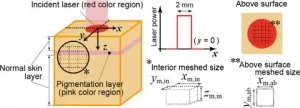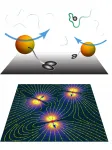(Press-News.org) URBANA, Ill. - Ever thought about buying or building a bat box to help bats? Think carefully about the design and where you put it, University of Illinois researchers say.
Here's why: Bats and their pups can overheat and die in poorly designed or placed bat boxes, and in a warming climate, it could happen more often.
Illinois bat ecologists Joy O'Keefe and Reed Crawford recently synthesized the available data on bat boxes, also known as bat houses or artificial roosts, to raise awareness of the issue and motivate change in bat box design, marketing, and consumer education. Their recommendations are published in Conservation Science and Practice.
"Conservation practitioners and homeowners are well-intentioned; they want to help bats. Inevitably, the first thing they do is go online and buy a bat house," says Crawford, a doctoral student in the Program in Ecology, Evolution, and Conservation Biology at Illinois. "But unfortunately, a lot of bat houses on the market are small and painted dark colors, and they get hot really quickly. They're likely to hurt bats if they're installed in the wrong spot.
"We're trying to highlight that there's a lot of misleading information out there. We want to steer people away from putting up bat boxes as a first course of action, to instead consider the risks and ask if there is anything we can do that's going to be more beneficial for bats."
Crawford has read just about every study that's ever been done on bat boxes, and he and O'Keefe have conducted their fair share of studies, as well. They and other members of the bat research community have identified a critical temperature threshold - 104 degrees Fahrenheit or 40 Celsius - above which most bat species are significantly heat-stressed.
Although very few studies have documented temperatures inside the countless bat boxes currently in use across the world, researchers have recorded temperatures as high as 142 degrees Fahrenheit in artificial roosts. And they've observed bats in natural roosts moving to avoid temperatures above 97 degrees.
In many bat boxes, bats can't move around to avoid hot spots. The most common design is a small, flat-panel box with vertical slats creating one to four chambers. The boxes are often painted or stained dark colors, and that can be a big part of the problem.
"We know darker boxes can be, on average, 41-43 degrees hotter than white boxes and are more likely to overheat. Yet we see companies marketing black boxes as preferable to bats and suitable for most U.S. climates," Crawford says. "But one hot summer day in a really tiny black bat house is probably going to kill anything that's in there. So it's very dangerous."
O'Keefe, an assistant professor and wildlife extension specialist in the Department of Natural Resources and Environmental Sciences at Illinois, adds, "Even our colleagues in cooler climates have seen a number of bat deaths in dark-colored boxes. That's why we advocate for not painting boxes in dark colors."
But she points out that bat deaths have also occurred in unpainted, light-wood boxes in warm climates. "Clearly, more intervention is needed than just the color of the box."
Bats do like to be warm and protected when they're sleeping and raising their young. But when they're seeking out natural roosts in the wild, they choose spots that allow them some flexibility to move when it gets too hot.
That's why Crawford and O'Keefe say if you're going to invest in a bat box, large designs are better. For example, tall, four-sided boxes allow bats to move up and down in space and around to the back side when the front is being blasted by sun.
Researchers are also investigating novel materials and design elements that are better temperature buffers than the usual plywood, including wood-cement (a molded mixture of wood shavings and cement), insulating water chambers, and chimneys.
But regardless of design and color, placement has implications that go beyond overheating.
"Obviously, you're going to want to avoid hanging a small, dark bat house where it's going to get direct sun all day, especially in warmer, southern climates," Crawford says. "But we're just starting to learn about how artificial roosts might represent ecological traps for bats. They could be preferentially selecting the bat box because of where it is and passing over natural habitats that would keep them safer from predators and parasites, as well as dangerously warm temperatures."
O'Keefe adds, "Bat houses can also draw bats to areas that are inappropriate. That's one of the reasons I've moved away from advising people to put out bat boxes as a first step in bat conservation. People need to think about what they're drawing bats to. Do they have to cross any difficult boundaries, like busy roads, to get there?
"I encourage homeowners to think about doing something else that could benefit bats instead, like planting native trees or wildflowers to attract insect prey, providing clean water sources, or leaving standing dead trees wherever it is safe to do so, as these are natural roosting habitat for bat box users."
INFORMATION:
The article, "Avoiding a conservation pitfall: Considering the risks of unsuitably hot bat boxes," is published in Conservation Science and Practice [DOI: 10.1111/csp2.412].
The Department of Natural Resources and Environmental Sciences is in the College of Agricultural, Consumer and Environmental Sciences at the University of Illinois.
A pilot human clinical trial conducted by researchers at Baylor College of Medicine reveals that supplementation with GlyNAC - a combination of glycine and N-acetylcysteine as precursors of the natural antioxidant glutathione - could improve many age-associated defects in older humans to improve muscle strength and cognition, and promote healthy aging.
Published in the journal Clinical and Translational Medicine, the results of this study show that older humans taking GlyNAC for 24 weeks saw improvements in many characteristic defects of aging, including ...
In the Arctic, climate change and pollution are the biggest threats to top predators like narwals. Studying the animals' tusks reveals that diet and exposure to pollution have shifted over the past half century in response to sea-ice decline. Human emissions have also led to a sharp rise in the presence of mercury in recent years, according to an international team of researchers.
"Our research shows that climate change is having substantial impacts on Arctic ecosystems, with consequences for exposure to toxic pollutants like mercury," says co-author Jean-Pierre Desforges, a Postdoctoral Fellow at McGill University under the supervision ...
Alexandria, Va., USA -- Asymptomatic carriage of SARS-CoV-2 is a potentially significant source of transmission, yet remains relatively poorly understood. The study "SARS-CoV-2 Positivity in Asymptomatic-screened Dental Patients" published in the Journal of Dental Research (JDR), investigated SARS-CoV-2 infection in asymptomatic dental patients to inform community surveillance and improve understanding of risks in the dental setting.
Thirty-one dental care centers across Scotland invited asymptomatic screened patients over the age of five to participate. During the patient visit, trained ...
Laser treatment is now commonplace across various fields of medicine including dermatology, where it is commonly used to remove scars, wrinkles, and freckles. The technology, however, has a major downside: despite continued improvements, medical accidents related to laser treatment has been on the rise, with studies revealing excessively high laser energy as the major cause of such accidents.
Assistant Professor Takahiro Kono from Shibaura Institute of Technology (SIT), Japan, whose research is focused on the mechanism of heat transfer involved in the interaction of laser light with biological tissue explains, "The difficulty lies in adjusting the laser conditions for each patient ...
A team of researchers led by UCL Great Ormond Street Institute of Child Health (ICH) and Great Ormond Street Hospital (GOSH) has found that metformin - a drug commonly used to treat Type 2 diabetes - can successfully reduce symptoms associated with tuberous sclerosis complex (TSC), including reduction in the frequency of seizures and the size of brain tumours.
The study, which also included teams from Royal United Hospitals Bath NHS Foundation Trust (RUH) and University Hospitals Bristol and Weston NHS Foundation Trust, recruited 51 patients with TSC who were randomly assigned a placebo or metformin for one year on a dose similar to that given for Type 2 diabetes.
TSC is a genetic disorder characterised ...
In order to develop more effective drugs against a range of cancers, researchers have been investigating the molecular structure of many diseased-linked enzymes in the body. An intriguing case in point is Taspase 1, a type of enzyme known as a protease. The primary duty of proteases is to break down proteins into smaller peptide snippets or single amino acids.
Taspase 1 appears to play a vital role in a range of physiological processes, including cell metabolism, proliferation, migration and termination. The normal functioning of Taspase 1 can go awry however, leading to a range of diseases, including leukemia, colon and breast cancers, as well as glioblastoma, a particularly lethal and incurable malignancy in the brain.
Because Taspase 1 dysregulation is increasingly ...
Use of vouchers and coupons offered by pharmaceutical companies to defray patients' out-of-pocket drug costs is concentrated among a small number of drugs. While these offsets significantly reduce patient costs, they are not targeted to patients who most need the price reduction, according to a study from researchers at the Johns Hopkins Bloomberg School of Public Health.
The researchers, in what is thought to be the largest study of its kind to date, analyzed tens of millions of pharmacy transactions by more than 600,000 people in the U.S. during 2017-19, in order to get a better sense of how vouchers and other point-of-sale copayment "offsets" are used. These coupons and vouchers come in many forms--some are offered online directly to customers, others by pharmacy ...
When you bump into someone in the workplace or at your local coffee shop, you might call that an "encounter." That's the scientific term for it, too. As part of urgent efforts to fight COVID-19, a science is rapidly developing for measuring the number of encounters and the different levels of interaction in a group.
At the National Institute of Standards and Technology (NIST), researchers are applying that science to a concept they have created called "encounter metrics." They have developed an encrypted method that can be applied to a device such as your phone to help with the ultimate goal of slowing down or preventing future pandemics. The method is also applicable to the COVID-19 pandemic.
Their research ...
A drop of food coloring slowly spreading in a glass of water is driven by a process known as diffusion. While the mathematics of diffusion have been known for many years, how this process works in living organisms is not as well understood.
Now, a study published in Nature Communications provides new insights on the process of diffusion in complex systems. The result of a collaboration between physicists at Penn, the University of Chile, and Heinrich Heine University Düsseldorf, this new theoretical framework has broad implications for active surfaces, such as ones found in biofilms, active coatings, and even mechanisms for pathogen clearance.
Diffusion is described ...
BUFFALO, N.Y. - Bullying at boarding schools has a negative impact on students' emotional health, but for male students, having a school staff member to rely on for support may mute the harmful effects of bullying, according to a new University at Buffalo study. Support networks did not have the same effect for female students, the researchers say.
The study, recently published in School Psychology Review, is one of few to examine the impact of bullying at boarding schools, which provide a unique environment where most students live on school grounds, away from their families. It is also one of the first studies to observe the effects ...




